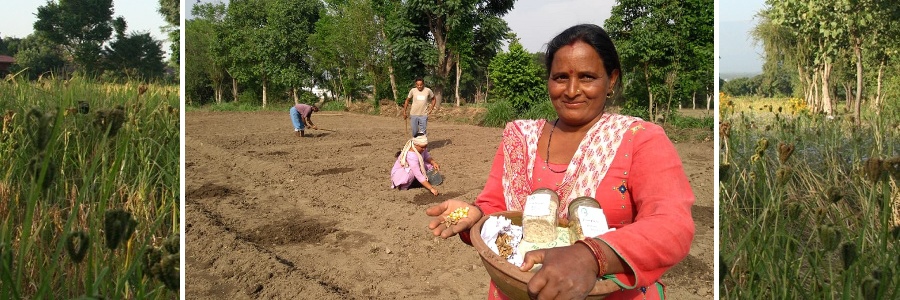
By Dr Vandana Shiva, 22 May 2018
This biodiversity day start growing biodiversity and eating biodiversity for the health of the planet and your health.
22nd of May is World Biodiversity Day. For me it is a special day, because my life’s journey has been a biodiversity journey – from the days of Chipko in the 1970s, to the study of the Green Revolution in the 1980s, and the saving of our seeds and biodiversity from our fields to our plates to our gut microbiome.
The dependence on fossil fuels and chemicals has made us forget the richness of biodiversity. Every move away from biodiversity has left us poorer in every aspect – ecological, cultural, political economic.
While fossil fuels and chemicals create what I have described as “monocultures of the mind”, biodiversity allows us to see the diversity of relationships, functions, potentials, possibilities. Monocultures and uniformity create the urge to exclude and exterminate. They generate hierarchies, domination and hate.
Biodiversity creates the possibility of unity in and through diversity. It transforms heirchies into horizontalities of mutualities, interdependence, giving and receiving.
Our work in Navdanya has shown that we can control pests through biodiversity. We can double nutritional security through biodiversity. We can double farmers’ incomes through biodiversity. We can move towards sustainability justice and peace through biodiversity. We can ensure sustainable development by protecting the ecological space of other species.
The international community has committed itself to Sustainable Development goals for the next decade. On 4th of May, we celebrated World Biodiversity Day with the CM of the Government of Sikkim on the theme “Biodiversity and the SDGs: Sustainable Livelihoods and protecting the planet”. If one looks at the first 3 goals which are central to human well being, we can address them by protecting and rejuvenating biodiversity, not by annihilating and exterminating species through chemicals and toxics, trapping farmers in a debt trap for chemicals they don’t need if they grow biodiversity, and spreading a disease epidemic because of nutritionally empty toxic food.
SDG GOAL 1 is No Poverty: End poverty in all its forms everywhere
Biodiversity can reduce poverty by providing livelihoods as well as basic needs. When farmers practice biodiverse organic farming they do not need to buy costly seeds and costly chemicals, which is the main reason for rural debt and farmers suicides. They grow more nutritious and more diverse food, and can increase their incomes. Biodiversity of crops and of markets is the road to doubling farm incomes.
SDG GOAL 2 is Zero Hunger: Achieve food security and improved nutrition and promote sustainable agriculture
“It is time to rethink how we grow, share and consume our food.” For three decades we have been promoting a biodiverse model of farming. The green revolution, which introduced the “improved seeds”, extended the monocultures, reduced or canceled the peasant farming for food, has also drastically reduced both natural and agricultural biodiversity, and varieties, such as rice, in India and other countries (V. Shiva, The violence of Green Revolution, 1991).
The Green Revolution model has been based on a misleading measure of “yield per acre. “We measure “nutrition per acre.” We grow more nutritious food because we return more nutrition to the soil. We grow traditional seeds which farmers have bred for nutrition, not nutritionally empty crops bred for high response to chemicals. Scientific research is showing that traditional varieties have higher nutrition, more taste, more quality than industrially bred varieties. Our wheat varieties do not give gluten allergies , but industrial wheats do.
SDG GOAL 3 is Good Health and Well-being: Ensure healthy lives and promote well-being for all at all ages
Biodiversity is central to health from the soil to our fields, to our gut microbiome. There is an intimate connection between the soils, the plants, our gut and our brain. Our gut is a microbiome which contains trillions of bacteria. There are 100,000 times more microbes in our gut than people on the planet.
To function in a healthy way, the gut microbiome needs a diverse diet, and a diverse diet needs diversity in our fields and gardens. A loss of diversity in our diet creates ill health.
The destruction of biodiversity is driving a chronic disease epidemic of non communicable chronic diseases which account for 70% deaths globally. This translates to 40 million lives lost each year .Most chronic diseases are diet related .Both farmers suicides and deaths due to chronic diseases are rooted in a agriculture and food system which has ignored the health of the planet and health of people. Biodiverse diets free of toxins are the solution to both the agrarian crisis and the health crisis.
There has been a historical reduction of biodiversity and the depletion of natural substances ingested in food. 75% genetic diversity has disappeared in one century only.
Diverse cultures have eaten diverse plants Farmers have evolved hundreds of thousands of crops since the beginnings of agriculture, a considerable amount of biodiversity has built up in crop production. The application of reductionist methods based on uniformity to plant breeding, however, has led to the substitution of traditional local varieties by widespread genetically homogeneous varieties, and a dramatic loss of diversity.
From 10,000 species originally, barely more than 150 species are now under cultivation and the great majority of mankind is now living off no more than 12 plant species.
This biodiversity day start growing biodiversity and eating biodiversity for the health of the planet and your health. Plant a garden in your balcony or terrace or even one plant of Tulsi in your window. Relate directly to farmers who grow the good food you need and not eat the poisoned food that corporate food systems are bringing you.
Most importantly let us together in our diversities start regriwing our ecological civilization based on Vasudhaiv Kutumkam –the Earth as one family, united in diversity, not divided by the imposition of uniformity.
